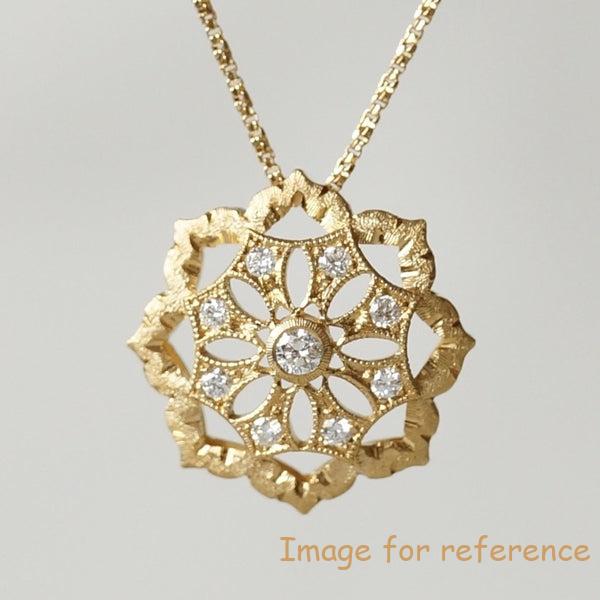공허함의 정확성: 맞춤형 꽃 펜던트를 위한 JINGYING의 CNC 피어싱 기술
목차
-
보석 제조 분야의 CNC 피어싱 소개
-
꽃무늬 피어싱 펜던트에 대한 시장 수요
-
클라이언트 프로필: 설계 요구 사항 & 기대
-
꽃무늬 펜던트의 기술 사양
-
피어싱 주얼리의 소재 선택
-
CNC 피어싱 기술 설명
-
단계별 제조 공정
-
표면 마무리 기술
-
품질 관리 조치
-
생산 과제 & 솔루션
-
포장 & 프레젠테이션
-
사례 연구: 10,000 단위 주문 이행
-
기존 방법과의 비교 분석
-
클라이언트 피드백 & 시장 반응
-
CNC 쥬얼리의 미래 발전
-
결론: 정밀한 공허함의 예술
1. 보석 제조 분야의 CNC 피어싱 소개
피어싱 금속 세공 기술은 수세기 전으로 거슬러 올라갑니다., 하지만 현대 CNC (컴퓨터 수치 제어) 기술은 이 고대 공예에 혁명을 일으켰습니다.. JINGYING의 고급 CNC 피어싱 시스템은 디지털 정밀도와 예술적 표현을 결합합니다., 특히 섬세한 꽃무늬 펜던트 디자인에 적합합니다.. 이 백서는 당사의 독점 기술을 검토합니다. 다축 마이크로 피어싱 시스템 (지도) 최근 10,000개의 꽃 펜던트 주문을 통해.

CNC 피어싱의 주요 장점:
-
±0.01mm 치수 정확도
-
85% 물질적 낭비 감소 vs. 레이저 절단
-
연동 피어싱 패턴 생성 기능
-
32차 작업 없이 D 언더컷
2. 꽃무늬 피어싱 펜던트에 대한 시장 수요
글로벌 주얼리 트렌드 (2024):
-
피어싱 디자인은 다음을 고려합니다. 38% 펜던트 판매 대비 (맥킨지 럭셔리 보고서)
-
꽃 모티브는 다음과 같습니다. 62% 자연에서 영감을 받은 주얼리
-
925 실버 피어싱 펜던트 쇼 22% 전년 대비 성장
소비자 선호도:
-
섬세하지만 내구성이 뛰어난 구조
-
가벼운 착용성 (15g 미만)
-
“시스루” 입체 효과
-
맞춤형 개인화 옵션
3. 클라이언트 프로필: 설계 요구 사항
고객: 스칸디나비아 주얼리 브랜드 (동쪽 . 2015)
-
미적인: 미니멀리스트 북유럽 꽃무늬 디자인
-
주문 수량: 10,000 단위 (5 변형)
-
주요 요구 사항:
-
0.3-0.5mm 피어싱 폭 일관성
-
눈에 보이는 도구 표시가 없습니다.
-
무게 제한: 12펜던트당 g
-
1.5mm 체인과 호환 가능
-
4. 기술 사양
| 매개변수 | 사양 |
|---|---|
| 치수 | 25밀리미터 × 18mm × 1.8mm |
| 재료 | 925 스털링 실버 |
| 피어싱 폭 | 0.4mm ±0.05 |
| 무게 | 10.8-11.2g |
| 보석금 개시 | 1.6mm ID |
| 표면 마감 | 거울 광택제 + 선택적 산화 |
CAD 디자인 기능:
-
87 관통된 요소 교차
-
3-레이어 깊이 환상
-
숨겨진 구조적 보강재
-
맞춤 제작을 위한 각인판
5. 재료 선택의 이론적 근거
925 피어싱의 은색 장점:
-
최적의 가공성 (모스 2.5-3)
-
CNC 작업 중 공구 마모 최소화
-
뛰어난 광택 유지력
-
적절한 코팅으로 변색 방지
대체 재료 고려:
-
금: 세세한 부분까지 표현하기에는 너무 부드럽습니다.
-
티탄: 얇게 뚫기 힘든데
-
놋쇠: 추가 도금 필요
6. CNC 피어싱 기술 심층 분석
JINGYING의 MAPS 시스템 사양:
-
5-축 동시 제어
-
50,000 RPM 스핀들 속도
-
0.1mm 카바이드 마이크로 공구
-
절삭유가 필요 없는 건식 가공
-
실시간 공구 마모 보상
고유한 기능:
-
15° 언더컷 피어싱
-
가변 폭 피어싱 (0.2-1mm)
-
기계 내 디버링
-
자동화된 도구 변경 (12-도구 회전 목마)
7. 단계별 제조
단계 1: 디지털 준비
-
CAD 파일 최적화 (솔리드웍스)
-
도구 경로 시뮬레이션 (마스터캠)
-
자재 효율성을 위한 네스팅
단계 2: CNC 가공
-
황삭 (0.8mm 엔드밀)
-
준마무리 (0.4mm 볼 노즈)
-
정밀 피어싱 (0.1mm 테이퍼 도구)
-
보석금 굴착 (1.6mm 드릴 비트)
-
조각 (30°V 비트)
단계 3: 후처리
-
초음파 청소
-
자기 텀블링 (8 시간)
-
핸드 폴리싱 (바퀴 + 화합물)
-
로듐 도금 (선택 과목)
8. 표면 마무리 기술
다단계 연마 공정:
-
배럴 텀블링 (24시간)
-
미세 연마제 분사 (선택 영역)
-
수동 버핑 (모슬린 바퀴)
-
전해연마
-
변색 방지 코팅 (3μm 두께)
품질 검증:
-
흰장갑 검사 (10× 배율)
-
무게 허용범위 확인 (±0.2g)
-
피어싱 폭 측정 (광학 비교기)
9. 품질 관리 프로토콜
| 검문소 | 방법 | 기준 |
|---|---|---|
| 치수 정확도 | CMM | ±0.05mm |
| 피어싱 청결도 | 현미경 | 버 없음 >0.02mm |
| 폴란드 품질 | 라이트 챔버 | 라 ≤0.1μm |
| 보석 강도 | 5kg 당김 테스트 | 변형 없음 |
| 재료 순도 | XRF | 92.5-93% Ag |
10. 생산 과제 & 솔루션
도전 1: 미세한 부분의 공구 파손
해결책: 적응형 이송 속도 제어 구현
도전 2: 피어싱 폭의 일관성 유지
해결책: 온도 제어 가공 환경 개발
도전 3: 후가공 부품 핸들링
해결책: 맞춤형 3D 프린팅 고정 장치
11. 포장 혁신
보호 포장:
-
개별 PETG 형태에 꼭 맞는 인서트
-
산소 제거제가 포함된 변색 방지 스트립
-
긁힘 방지 내부 코팅
소매 포장:
-
FSC 인증 종이박스
-
내장형 NFC 인증 칩
-
다국어 관리 지침
12. 사례 연구: 10,000 단위 주문
생산 지표:
-
수율: 98.7%
-
평균 가공 시간: 23 조각당 분
-
자재 활용: 82%
-
정시 배송: 100%
고객 ROI:
-
소매가: €189-€249
-
판매율: 91% 1분기에
-
고객을 위해 180만 유로의 수익 창출
13. 비교 분석
VS 레이저 절단:
-
40% 더 빠른 생산
-
더 나은 가장자리 품질
-
열 영향 구역 없음
VS 전통적인 핸드 피어싱:
-
300% 일관성 개선
-
65% 비용 절감
-
설계를 정확하게 복제하는 능력
14. 클라이언트 피드백
“JINGYING의 CNC 피어싱의 정밀도 덕분에 이전에는 렌더링에서만 가능하다고 생각했던 디자인을 구현할 수 있었습니다.. 우리의 미적 비전에 대한 기술팀의 이해는 놀라웠습니다.”
15. 향후 개발
차세대 피어싱 기술:
-
AI 기반 도구 경로 최적화
-
하이브리드 덧셈/뺄셈 시스템
-
나노스케일 피어싱 기능 (0.05mm)
-
자가 청소 피어싱 도구
16. 결론
JINGYING의 CNC 피어싱 기술은 르네상스 장인정신과 산업의 완벽한 결합을 나타냅니다. 4.0 정도. 이 사례 연구는 첨단 제조 기술이 전례 없는 정확성과 반복성을 통해 가장 섬세한 꽃 디자인에도 생명을 불어넣는 방법을 보여줍니다..
주요 시사점:
-
CNC 피어싱은 이전에는 불가능했던 설계 복잡성을 가능하게 합니다.
-
재료 과학은 가공 매개변수만큼 중요합니다.
-
절단 못지않게 후가공이 최종 품질을 좌우합니다
-
모든 피어싱 디자인에는 고유한 도구 경로 전략이 필요합니다.
금속 공허함의 한계를 뛰어넘고자 하는 디자이너를 위한 제품, 우리의 문과 CNC 워크스테이션은 항상 열려 있습니다..
